Calendar of the most important festivals in Peru
Peru is a land full of culture and traditions. These are manifested in all their magnitude in the festivities. Dances, music and delicious gastronomy are the activities that attract the most attention in these celebrations. Most have a religious background. They were born many years ago, even from the same viceregal period. When are they held? How do they develop? Which are? Learn about the main festivities of Peru.
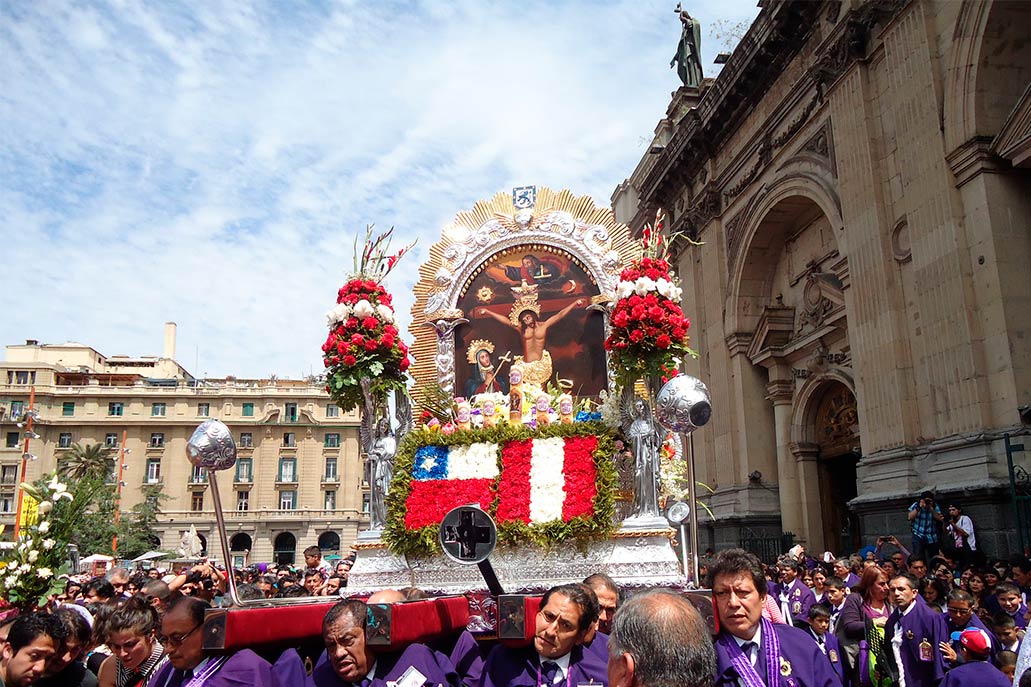
Content
New year
The New Year is a celebration that takes place in almost every country in the world. In Peru it has its own characteristics that, in turn, vary according to the region. The elements present in almost all of the Peruvian territory are: the delicious gastronomy made of turkey and suckling pig as well as the joy, the yellow clothing for good luck and the cabals.
Suckling pig is usually eaten in the Andean regions. On the coast, turkey is the main dish for the evening. Twelve grapes are eaten throughout the country at midnight on December 31st. Each represents good luck for the twelve months of the coming year. Celebrations with music and dance are present everywhere.
- Date: January 1st.
- Places: All of Peru.
Feast of the Virgin of the Calendaria
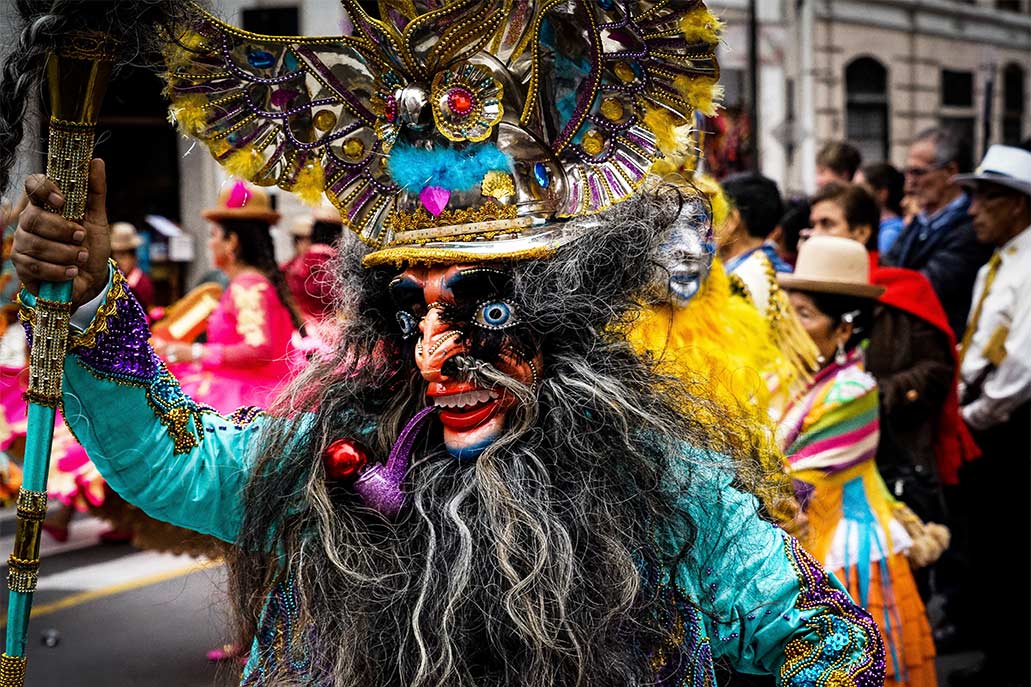
The festival in homage to the Virgen de la Candelaria is celebrated in various towns in Peru. However, it is in the city of Puno where it manifests itself with more roots and joy. There the Christian traditions were mixed together with the worldview of the Aymara peoples. The result is a massive celebration with hundreds of groups of dancers wearing very striking costumes.
It is estimated that 40,000 dancers and 200 musical bands participate in the party. The dance competition takes place on the main day (February 2) at the Enrique Torres Belón stadium in Puno. Then the celebrations spread throughout the city. This festival is also celebrated in Arequipa, Lima, Ayacucho and more. In 2014 this celebration was inscribed on the representative list of Intangible Cultural Heritage of Humanity.
- Date: February 2nd.
- Places: Mainly in Puno.
Carnivals in Peru
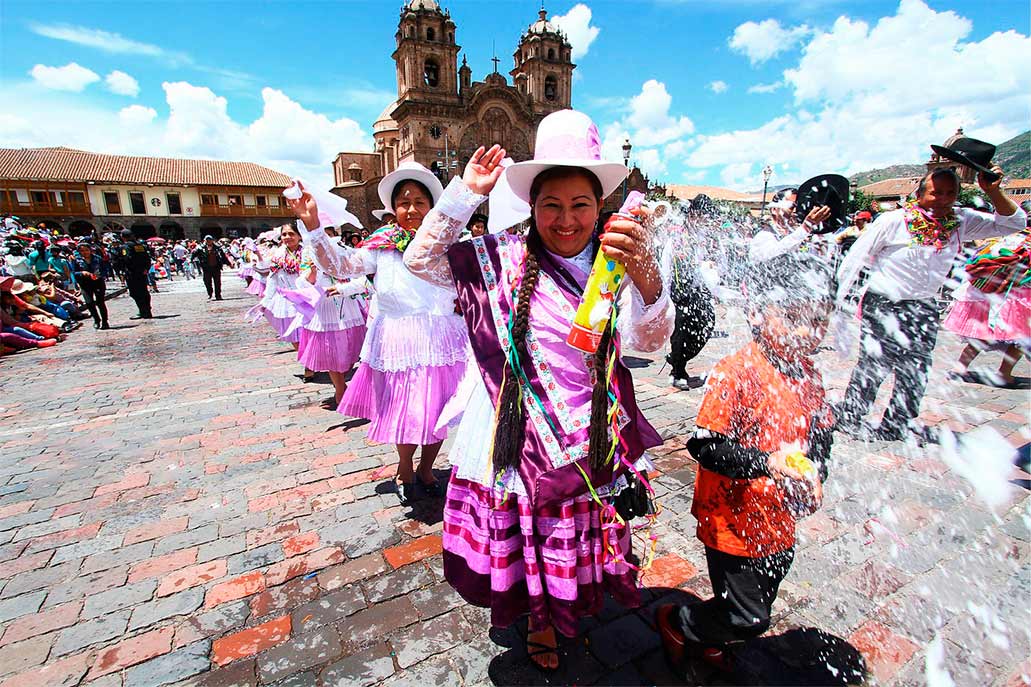
Carnivals are present in several countries in South America. In Peru these are characterized by games with water, talcum powder, picapica as well as dances, music and general joy. The regions of Peru where the best carnivals are celebrated are: Puno, Cusco, Ayacucho, Arequipa, Catacaos and, above all, Cajamarca.
Cajamarca carnivals are characterized by color, dances, music and general joy. The entire local population as well as visitors from other cities, including from abroad, participate in the parade. The most famous dances are: the Cilulo, the Carolina, the Cumbe cumbe and the Matarina. In the Andean towns throughout Peru, people dance around the unsha or tree full of gifts. It is the most joyous holiday in Peru.
- Date: Late February or early March (movable date).
- Places: All of Peru, especially in Cajamarca.
Holy Week
Holy Week is one of the most important religious festivals in Peru. It is celebrated throughout the territory, in each town and district of the country. Holy Thursday and Good Friday are declared holidays. The villagers go to the churches. There are processions, representations of the Passion of Christ and local gastronomic fairs. The cities of Peru where this date is celebrated with more fervor are in: Cusco, Arequipa, Lima, Ayacucho and Omate (Moquegua).
Holy Week in Cusco is characterized by the procession of the Lord of Earthquakes on Holy Monday. In Lima the characteristic representation of the Passion of Christ takes place on the Cerro San Cristóbal. In Omate there is also a massive representation of the Via Crucis as well as the construction of the ‘7 posas’ and the procession of the ‘Holy Sepulcher’. The traditional Easter of this town is recognized as Cultural Heritage of the Nation.
- Date: End of March or beginning of April (Movable date).
- Places: All of Peru, especially in Omate, Moquegua.
Feast of the Virgin of Chapi
The Virgin of Chapi is recognized as the Patron Saint of Arequipa. Every year thousands of devotees make a pilgrimage to their sanctuary located in the town of Polobaya, 60 kilometers from the city of Arequipa, also called ‘White City’. History relates that in the seventeenth century a strong earthquake occurred that led the people of Accahua to transfer the image of this saint to her current sanctuary in the so-called ‘Valle de Chapi’. There the faith in the invocation of the ‘Virgen de la Candelaria de Chapi’ was born.
In 1876 it was established that the celebration in honor of this virgin would be every May 1. Currently the celebration is attended by thousands of faithful from Arequipa and other regions of Peru. On the central day there are pilgrimages, processions, gastronomic fairs and more. In 1985 Pope John Paul II crowned the image of the saint. In 2012 it was declared as Cultural Heritage of the Nation.
- Date: May 1st.
- Places: Arequipa.
Corpus Christi
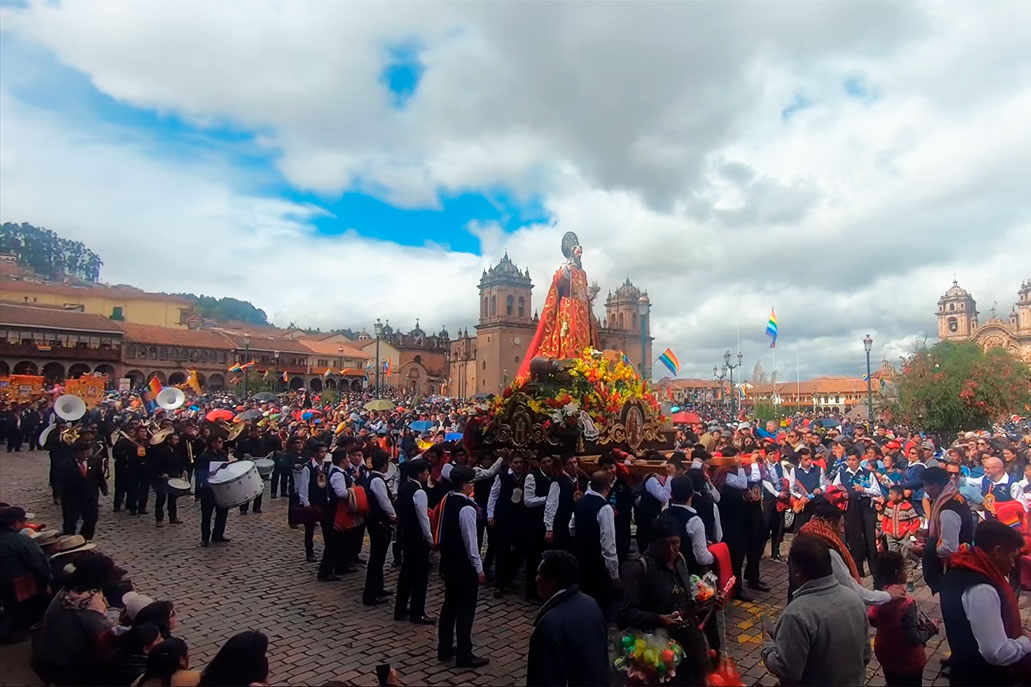
Corpus Christi is a Christian religious celebration established in Peru during the beginning of the Spanish colony in the 16th century. It takes place in different regions of the country, especially in Cusco where the famous procession of the fifteen main saints and virgins of the city takes place. Various researchers suggest that the background of this Cusco festival has its origins in the Inca tradition of walking the mummies of the rulers.
The Corpus Christi of Cusco begins with the departure in procession of the fifteen religious figures from their respective temples. The meeting point is the Cathedral of Cusco. After eight days, in the ‘eighth’ these saints and virgins are taken in procession to their respective temples. That day the Main Square is full of people. That day the delicious ‘Chiri Uchu’ is eaten.
- Date: 9 weeks after Holy Thursday (movable date).
- Places: Mainly in Cusco.
The Inti Raymi
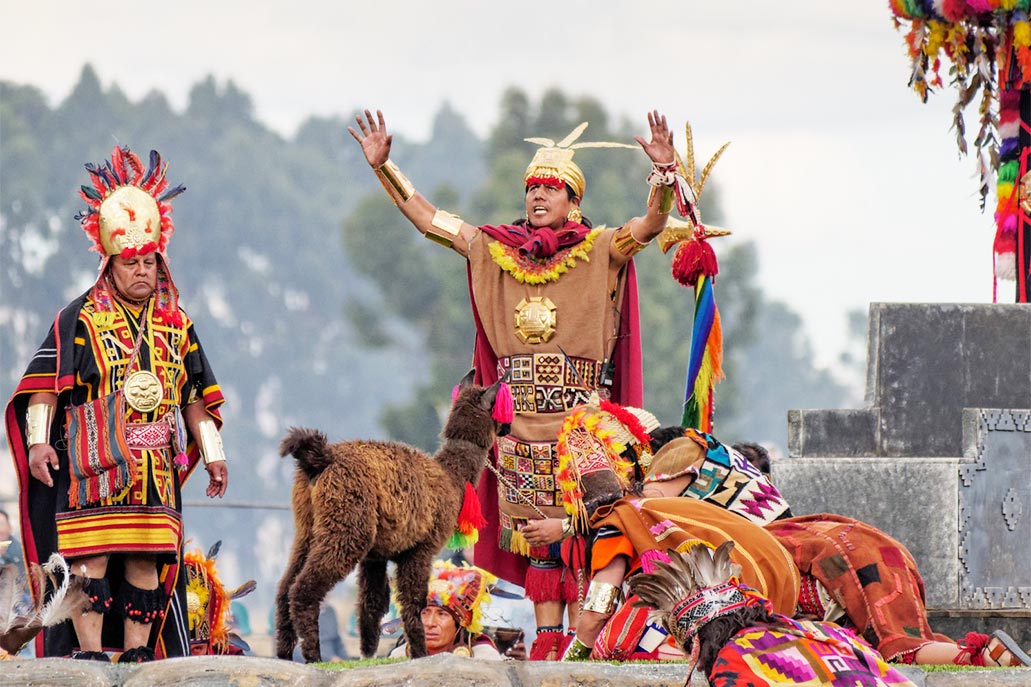
The Inti Raymi is the ‘Festival of the Sun’, a religious celebration of Inca origin that is celebrated in Cusco. It takes place on the winter solstice (June 24), when the sun is closest to the earth. The Incas worshiped the sun on this date through a massive ceremony in the Coricancha temple.
In 1944 the people of Cusco decided to reclaim their Inca past through a staging similar to the ‘Fiesta del sol’. Thus, today the Inti Raymi is a gigantic staging with hundreds of actors and actresses representing the Inca and his entourage in three historical settings: the Coricancha, the Main Square and Sacsayhuaman. This festival attracts thousands of foreign tourists. That day is declared a holiday in Cusco.
- Date: June 24.
- Places: Cusco.
The Feast of San Juan
The Fiesta de San Juan is the most important celebration in the entire Peruvian Amazon. It takes place in the regions of Loreto, San Martín and Ucayali, where San Juan Bautista is the main patron. Today this festival is celebrated in all the towns of the Amazon. The main characteristics are the color, the delicious local gastronomy, the music, the dance and the general joy.
In Iquitos, capital of the department of Loreto, the festival is characterized by a parade with typical clothing from the area. Music shows are held at night. In Pucallpa, capital of Ucayali, beauty contests and fireworks show are held. Throughout the Amazon, the star dish is ‘Juane’. Hundreds of tourists flock to the jungle towns for this date.
- Date: June 24.
- Places: The towns of the jungle of Peru, mainly in Loreto, Ucayali and San Martín.
Patriotic Holidays
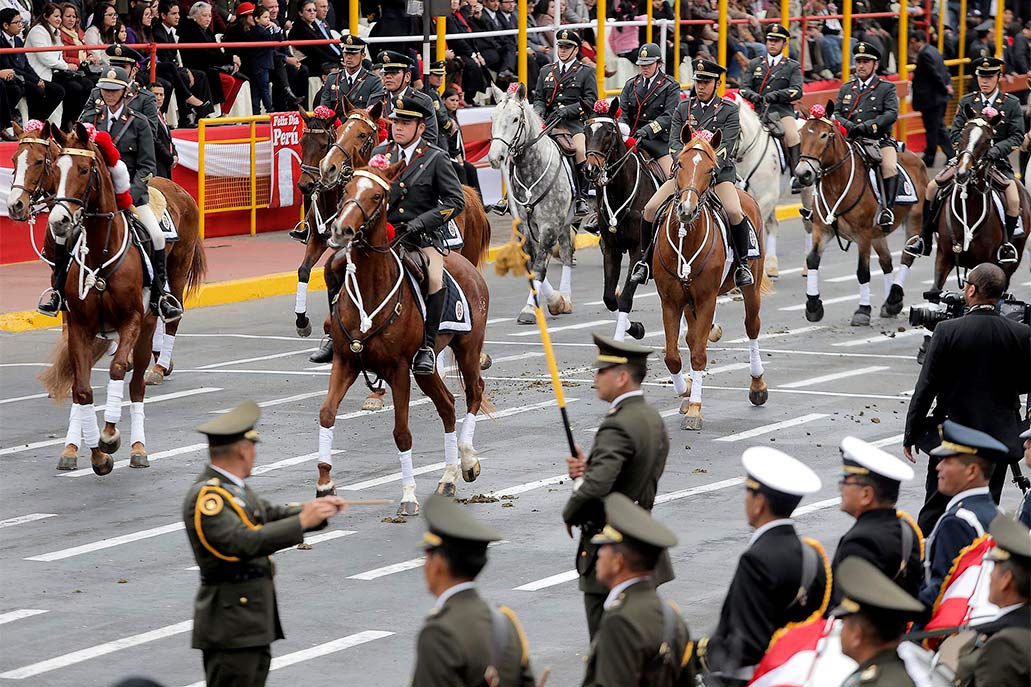
On July 28, 1821, General Don José de San Martín proclaimed the Independence of Peru in the Main Square of Lima. Since then, every year on this date Peruvians celebrate their national holidays. All over the country houses display their red and white flag. Patriotic parades are held in each main square with public and private entities. In each region there are dance shows and, in certain regions, musical shows.
The most important protocol events take place in the city of Lima, the capital of Peru. At night there are celebrations with music and cultural shows. That day is a national holiday. On July 29, a massive military parade takes place with the presence of the main authorities of the country, including the president.
- Date: July 28.
- Places: All of Peru.
Procession in honor of the Señor de los Milagros in Lima

The image of the Señor de los Milagros represents the most significant faith of the people of Lima. The story goes that his image was painted in 1651 by an African slave in the town of Pachacamilla, south of the city. In the 1665 earthquake, the entire construction collapsed except for the wall where this image lay. The same thing happened in the 1687 earthquake. In 1746 the population took this image in procession, seeking to appease the aftershocks of the 1687 earthquake. Since then it has been known as ‘El Señor de los Temblores’.
Today the ‘Cristo Moreno’ (because his first faithful were Afro-descendants) has his temple in the Church of the Nazarenas in the center of Lima. Every October 18, 19 and 28, the people of Lima walk in procession to the Señor de los Milagros along the historic streets of the city. His most devoted faithful wear purple robes. During these dates people like to try the sweet ‘nougat limeño’. Throughout the city there are replicas of the image that also go out in procession.
- Date: October 18, 19 and 28.
- Places: Lima.
Christmas
Christmas in Peru has many western features but also its own peculiarities according to each region. For example, in Cusco the Main Square opens its space for the sale of sculptures of saints and biblical figures in the famous ‘Santurantikuy’. In the province of Cañete (south of Lima) the celebration includes a show of children stomping, a tradition typical of the Afro-descendant culture of Peru.
On December 25, Peruvians usually taste baked turkey or suckling pig depending on the place in the country. Despite the heat on the coast (summer in December), hot chocolate is often drunk as well as panettone and sweets. At night it is usually celebrated with fireworks. Before midnight on Christmas the ‘mass of the rooster’ is celebrated. Gifts and family unity is the main characteristic.
- Date: December 25th.
- Places: All of Peru.
By Machupicchu Terra – Last updated, September 15, 2021